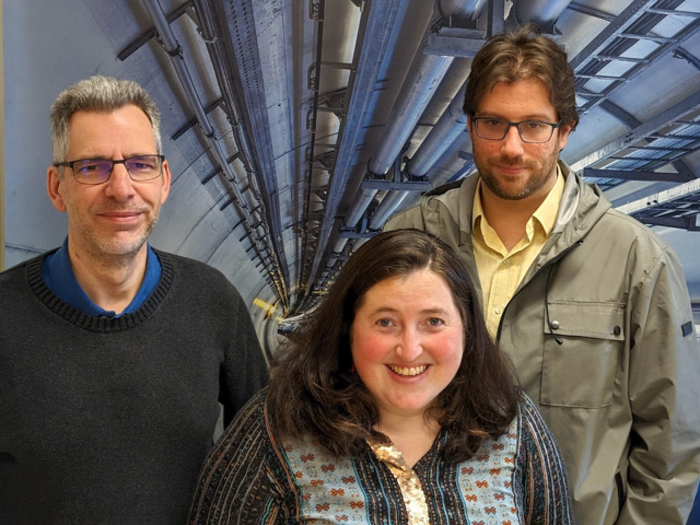December 8, 2022

Credit: UMass Amherst
December 8, 2022
AMHERST, Mass. – There is the universe we know, made of atoms and molecules, and another, more mysterious universe made of things like the Higgs boson, the top quark and other subatomic particles that have only been observed in laboratories. These particles live for only a fraction of a second, but without them the universe as we know it couldn’t exist. A team of physicists at the University of Massachusetts Amherst is playing a crucial role in the exploration of such subatomic particles, providing everything from leadership to next-generation computing and graduate training with the help of over $5 million in new research grants.
The team is part of the ATLAS Experiment, an international collaboration of more than 5,500 physicists, engineers and students, which uses the 17-mile-long Large Hadron Collider (LHC) straddling the France-Switzerland border to study the physics of subatomic particles. The LHC works by shooting two beams of particles at each other. Since each of the beams is traveling at nearly the speed of light, the particles crash into each other with phenomenal energy, creating new subatomic particles which are recorded by the ATLAS experiment. “It’s all a kind of microscope allowing us to see the smallest, most fundamental constituents of matter,” says Stephane Willocq, professor of physics at UMass Amherst and the newly appointed deputy spokesperson for ATLAS.
The goal of ATLAS is to answer some of the universe’s biggest unanswered questions: What are the basic building blocks of matter? What are the fundamental forces of nature? What is dark matter made of? Willocq notes that it was ATLAS that first detected the mysterious Higgs boson—the particle that gives everything else in the universe its mass. “And perhaps it is the Higgs boson that will serve as a portal to the new particles like dark matter,” Willocq continues.
The engineering behind the Large Hadron Collider and the ATLAS detector is impressive, as is the software and computing necessary to process the data collected by the experiment. To help accomplish the crucial computing tasks, Martinez Outschoorn was recently chosen as the new deputy manager for ATLAS-related software and computing operations and R&D for the 40 U.S.-based institutions contributing to the ATLAS project.
UMass Nets Four Grants to Further Computing, Software and High-Energy Physics
Unfortunately, the available training on how to effectively use the advanced digital tools required by a project like ATLAS has lagged behind technological gains. To address this educational shortfall, Willocq, along with his UMass Amherst physics colleagues, Verena Martinez Outschoorn and Rafael Coelho Lopes de Sa, were recently awarded a grant by the Department of Energy (DOE) to modernize education at the meeting point between high-energy physics, software and computing.
This effort involves designing a cutting-edge new curriculum that will allow graduate students to master the rapidly evolving software and computing techniques that are necessary for projects like ATLAS. “Graduate students in this training program at UMass Amherst will have a unique education that will include both particle physics and computer science”, says Coelho Lopes de Sa about the new traineeship program.
In a separate DOE grant, Willocq, Martinez Outschoorn, and Coelho Lopes de Sa will research the development of Artificial Intelligence methods in flexible electronic chips called Field-Programmable Gate Arrays (FPGA). These FPGAs will be used in the ATLAS detector to help identify new subatomic particles created in the LHC collisions. These new subatomic particles could include the long-sought dark matter.
The software and computing used by the ATLAS experiment requires constant development to match the challenges of the ever-increasing data set collected at the LHC. Coelho Lopes de Sa and Martinez Outschoorn were awarded a new grant by the National Science Foundation (NSF) to create collaborations between institutions in the U.S. and India to develop new software algorithms and computing approaches solutions required by particle physics. The award is part of the NSF AccelNet program, whose goal is to accelerate the process of scientific discovery and prepare the next generation of U.S. researchers for multiteam international collaborations.
Finally, Coelho Lopes de Sa and Martinez Outschoorn were awarded yet another NSF grant to build a new high-performance computing cluster at the Massachusetts Green High Performance Computing Center (MGHPCC). This new computing cluster will have over 10,000 CPUs and will be one of the largest computing systems at UMass Amherst. The new cluster will be part of the Worldwide LHC Computing Grid and bring several benefits to the campus, including improving the network connection to other research universities and national labs in the U.S. The cluster is expected to be operated until the end of the ATLAS experiment, in the 2040s.
“These four new awards will allow UMass Amherst to play a leading role in the intersection between experimental particle physics and computer science, in areas like artificial intelligence and high-performance computing. The new collaborations these projects bring will greatly improve the national and international profile of our research,” says Martinez Outschoorn.
Contacts: Verena Martinez Outschoorn, [email protected]
Daegan Miller, [email protected]




